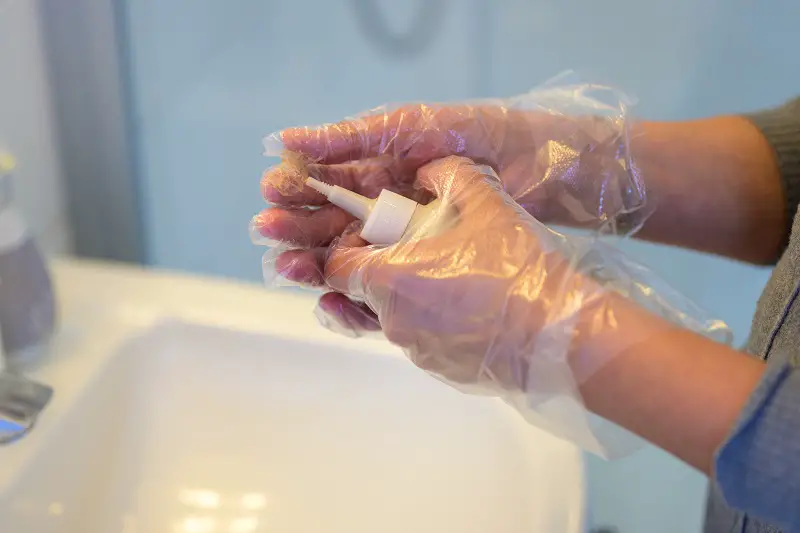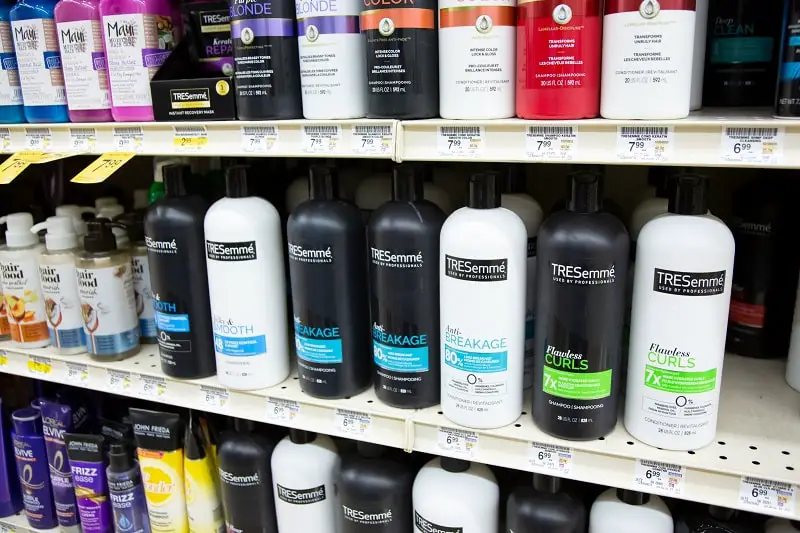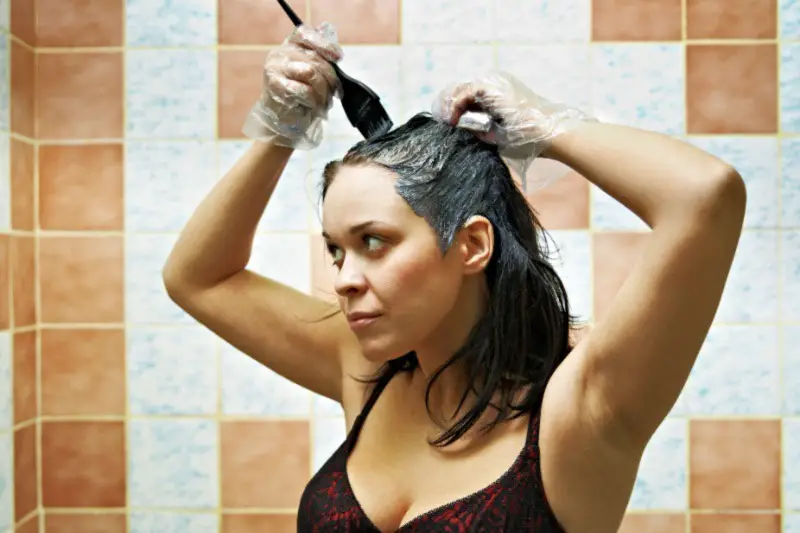Can you use hair dye without gloves? This may be a question you’ve asked yourself after a run to Target—hair dye and applicator in hand, ready to give yourself a makeover after that bad breakup.
However, once you get all the products mixed you realize … you forgot to buy gloves. Oh well, it’s such a small part of the hair dyeing process, right?
I don’t absolutely NEED gloves to dye my hair … or do I? What is the worst that could happen if I don’t make the extra trip to the store to buy some?
I will explain to you in this article why you should always, always use gloves when dyeing your hair and the risks you take if you choose not to. While it is not necessary to use gloves when dyeing your hair, I highly recommend that you do.
Can You Put Hair Dye On Without Gloves?
To keep things simple, yes you can. However, just because you can doesn’t mean you should. Not only do gloves prevent your hands from being stained with dye, they also protect your skin from irritation and burns caused by the chemical ingredients.
You don’t have to be someone with sensitive skin for hair dye to cause a reaction. The ingredients in most hair dyes on the market contain a chemical called P-phenylenediamine (PPD for short).
This chemical is derived from petroleum making it a coal-tar color. Despite the FDA approving coal-tar colors, there are many proven health risks involved, one of them being major skin sensitivity.
In order to protect at the very least your hands from being potentially chemically burned by PPD, gloves are the way to go. Gloves create a barrier between your hands and the harsh ingredients hair dyes contain.
Should I Wear Gloves To Wash Out Hair Dye?
In order to be fully protected, wearing gloves throughout the entire hair dyeing process is always recommended. There is not as much of a risk of irritation, however, there is always a risk that the harmful ingredients may be absorbed into your pores.
If exposure to chemicals in hair dyes isn’t enough to convince you, maybe hair dye stains will be. Hair dye stains can last anywhere from a few days to a few weeks. These stains can form in the beds of your nails making them last even longer.
The stains will stick around until your skin cells regenerate or you find a way to get rid of them. Wearing gloves avoids the possibility of hair dye staining your hands brown, blue, red, or whatever color you’ve chosen.
Can I Use Rubber Gloves to Dye Hair?
I’ve said it once and I’ll say it again, just because you can, doesn’t mean you should. Many studies and experiments have tested different types of gloves and their effectiveness when in contact with hair dye.
Out of rubber latex, vinyl, polyethylene, and nitrile gloves, all types besides nitrile were shown to fail at effectively preventing contact dermatitis.
Not only did these 3 types of material fail at protecting the skin, they caused an eczema type skin irritation when in contact with the hair color. In addition, using latex rubber gloves while in contact with harsh dye chemicals can lead to an allergic reaction to latex.
In order to prevent any type of skin irritation, regardless if you have sensitive skin or not, nitrile gloves are the only proven material to safely use when spicing up your look.
What Happens If You Touch Hair Dye?
When the toxins in hair dye touch your skin a variety of things can happen. Redness, itching, sores, and a burning sensation are among the most common.
These reactions are a direct result of the dye’s chemicals seeping in through your pores, wrecking havoc. Best case scenario, you have stained hands for an extended period of time. Worst case scenario, you end up with painful hives.
It is never a good idea to purposefully touch hair dye with bare hands. Our skin has a protective layer but it is not meant to withstand harmful chemicals such as bleach and ammonia, two ingredients commonly found in most dyes.
Can You Touch Hair Bleach With Your Bare Hands?
Every licensed cosmetologist will tell you to never, ever touch bleach with your bare hands. However, not everyone listens to professionals so it is good to know the effects bleach can have not only on your skin but the rest of your body if you decide to go this route.
Not only can bleach be a massive irritant to your skin’s outer layer, too much chlorine in your bloodstream can be toxic. Light damage to your hands may just consist of dry, gritty, painful skin with a
white-chalky discoloration to it.
Extensive damage may include symptoms such as an allergic reaction, nerve and tissue damage, and chemical burns. Using hair bleach without gloves also increases the risk of you touching your face, mouth, or eyes with such chemicals still present on your skin.
The liquid in your eyes will mix with the bleach to form an acid that can potentially cause extensive damage to your vision. All in all, using hair dye without gloves isn’t safe but using hair bleach without gloves is downright dangerous.
Can You Touch Hair Toner With Your Hands?
For those blondes out there who have to religiously tone and re-tone to get rid of that annoying brassy orange color, you may be wondering if using gloves is a necessity when performing this process.
While it is not as dangerous as bleach or hair dye, the chemicals used in hair toner are still harsh and still pose a risk of irritation to your skin’s outer layer.
In addition, hair toner can easily stain your hands or clothing so it is always recommended to wear protective gloves and an old t-shirt you don’t mind getting ruined.
What Happens If You Get A Little Bit of Hair Dye in Your Mouth?
In the event that hair dye has made its way into your mouth the first step to do is wash it out immediately and call the poison control hotline.
Washable hair dyes such as those used on Halloween shouldn’t be a huge cause for panic with symptoms such as minor mouth irritation and possible nausea and vomiting.
However, the risk of sickness or internal injury increases as you move towards semi-permanent and permanent hair dyes. This is because semi and permanent hair dyes include alkalizing and oxidizing properties.
The larger the amount of dye ingested the more likely it is you may experience severe irritation of the mouth, throat, and stomach accompanied by vomiting and a possible chemical burn.
Even small amounts of hair dyes containing PPD can cause life-threatening allergic reactions such as airway constriction and tongue swelling. No matter how small the amount, it is always a safe idea to consult with a poison control expert after the event dye has been ingested.
How Do You Get Hair Dye Off Your Skin?
Even if you do every step right AND you wear gloves, hair dye can stain all around your hairline, neck, ears, and any other place it somehow ends up. So, what do you do to get rid of those pesky stains?
There are a few ways to get rid of hair dye stains (or most of it):
Soap And Water
Good old-fashioned soap and water may do the trick. However, if you have larger, darker stains you may need something else.
Olive Oil
This is a natural way to strip dye from your skin. The oil needs a bit of time to work so dabbing the stain with a cotton ball soaked in olive oil and then placing a bandage over it while you sleep should take it off by morning.
Rubbing Alcohol
This option can be abrasive so it is not recommended for those with sensitive skin. Simply dab the stain with a cotton ball and then wash it off with warm water.
Toothpaste
Toothpaste was created for removing stains from teeth, so rumor has it it can work to remove stains from skin as well. Make sure you use a
non-gel paste, massage it into your skin for up to 10 minutes, and rinse off with warm water.
Nail Polish Remover
While this trick isn’t meant for your neck or face, using nail polish remover may help remove those pesky stains from your hands.
Baking Soda And Dish Soap
The properties in dish soap can help dissolve the dye stain, while the baking soda exfoliates, causing cells to turn over and stimulating regrowth. Use as a paste and massage into skin, then rinse with warm water.
Final Thoughts: Can You Use Hair Dye Without Gloves?
After everything we have discussed, it is clear that the risks far outweigh any benefits you’d have from choosing to dye your hair without gloves.
Skin irritation, allergic reactions, and dye stains are only a few of the problems that can arise when bare hands touch hair dye. Thankfully, most drugstore hair dyes include gloves in their kits, however, always make sure to check before purchasing.
In the event a dye kit does not come with gloves, using latex-free nitrile gloves not only ensures the best protection for your skin but also eliminates any possibility of an allergic reaction to the gloves themselves.
All in all, if you ever find yourself at home, ready to get this hair dyeing show on the road and you realize you don’t have gloves, take the time to go get some, otherwise, just wait. Your fresh look isn’t worth the painful risks that may follow.
Recommended
If you enjoyed reading this article, check out some of our other amazing blog posts:






